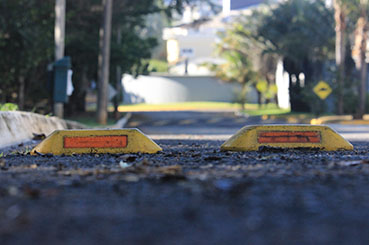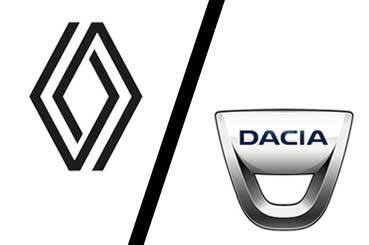When you’re driving along a dark, unfamiliar road at night, what guides you along safely? One of the unsung heroes of road safety is the humble road stud, more commonly known as “Cat’s Eyes.”
These small, reflective markers embedded in road surfaces play a significant role in aiding navigation and preventing accidents. In this blog, we’ll provide you with all you need to know about road studs (Cat’s Eyes), including how they work, their different colours and their meaning.

The History of Cat’s Eyes
The story of Cat’s Eyes begins with Cat’s Eyes inventor Percy Shaw, a British inventor who revolutionised road safety in 1934. After a foggy night, Shaw noticed how the reflective eyes of a cat glowed when caught in the beam of his car’s headlights. This observation sparked his creativity, leading to the invention of the cat’s eye reflector.
Shaw’s invention comprised a glass sphere held within a rubber housing, installed flush with the road surface. By reflecting light back towards the driver, these road studs provided a guiding path in low visibility conditions.
How Do Cat’s Eyes Work and How Are They Fixed to the Road?
Cat’s Eyes road reflectors work through a combination of retroreflection and total internal reflection. When car headlights hit the surface of the Cat’s Eye, the glass sphere inside the housing reflects the light back towards the source, i.e., the driver’s eyes.
The rubber housing ensures that the glass sphere remains protected and stable, allowing it to endure the pressures of heavy vehicles passing over them. Modern variations of Cat’s Eyes use more advanced materials and designs to enhance their effectiveness and durability.
The process of fixing Cat’s Eyes road studs to the road involves drilling a hole of the appropriate size and shape into the pavement. The housing is then inserted into the hole, leaving only the top of the sphere exposed. This design not only protects the reflective mechanism but also allows the road surface to be flush, preventing damage to vehicles passing over them.
Why Are Cat’s Eyes Different Colours and What Do They Mean?
Cat’s Eyes road studs are different colours to provide specific visual cues and guidance to drivers, helping them navigate various road conditions and situations effectively.

- White Cat’s Eyes are placed on the centreline of the road, guiding drivers in the correct lane. These are the most common reflective studs found in the UK.
- Amber Cat’s Eyes occur when driving within the third lane. These studs delineate the boundary that should not be crossed into the central reservation.
Similar to the red studs, these amber markers serve as aids for drivers, helping them identify the separation between the third lane and the central reservation, especially when visibility is poor or weather conditions are challenging. - Green Cat’s Eyes are often used to indicate exits or slip roads on motorways. These road studs guarantee that drivers can clearly discern the correct route to take when entering or exiting the motorway.
Particularly in situations with limited visibility, these studs serve as indicators for when drivers can safely signal to exit the main carriageway. In addition, green studs are utilised to highlight the locations of lay-bys on motorways and A-roads.
Furthermore, these road studs play a role in informing drivers about temporary alterations to the road layout, especially during extended roadwork periods. - Red Cat’s Eyes can be found when you find yourself in the left-hand lane, these reflective studs indicate areas where drivers must not cross the lines into the hard shoulder.
During misty or wintry conditions, these studs serve as guides to help you stay within the main three lanes and avoid drifting into lanes that should always remain clear.
Are Cat’s Eyes Here to Stay?

Given their proven track record in enhancing road safety, Cat’s Eyes are likely here to stay for the foreseeable future. However, technological advancements are continuously evolving the field of road safety.
Some areas are experimenting with more advanced road studs that incorporate LED lights or solar panels to make them even more visible and energy-efficient.
Cat’s Eyes, those unassuming road studs that guide us through the night, have a fascinating history and an essential role in road safety. Thanks to Percy Shaw’s ingenious observation, these small reflective markers have made a significant impact on reducing accidents and helping drivers navigate challenging conditions.
Their different colours and placements provide valuable information to drivers, ensuring safer journeys for all. As technology progresses, we can anticipate further innovations in road safety, but the trusty Cat’s Eyes are likely to remain a vital part of our road infrastructure.




